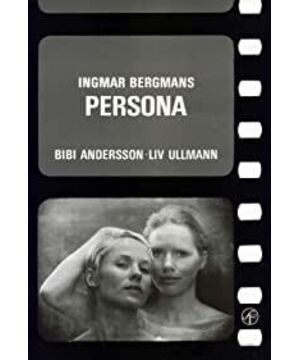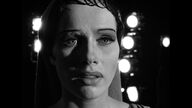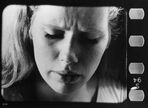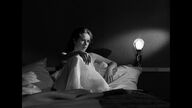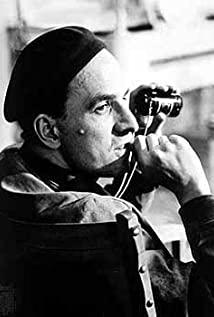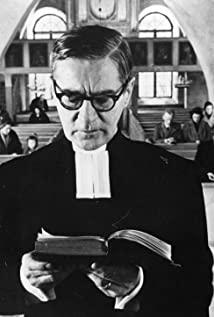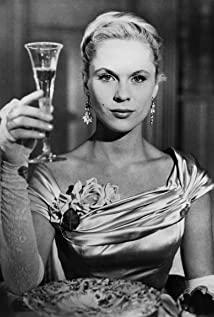In the early days, Bergman was obsessed with religious issues and always questioned the absence of God. In his later years, he paid more attention to realistic subjects such as family and marriage. "Mask" is a work of the director's link between the past and the next, concisely and abstractly summarized some basic motifs of his entire career as a director. First of all, it basically does not have the Christian elements that often appear in early movies, but only turned into ambiguous symbols such as nails nailed into the palm of the hand and the lamb being bleeded, and then he also took some other things he wanted to express, such as love and family affection. The hypocrisy is well integrated in the mysterious, complicated and ambiguous story of such a "personality exchange"
Elisabet represents the abstracted human rationality, which is what society requires "people" to behave. Her profession-an actor also illustrates this point. What she has done all her life is "act". -To please the audience, perfect but cold. According to the monologue repeated twice at the end, Elisabet has everything that an actor and a woman can have, but lacks motherhood. Correspondingly, Elma represents a person with true worldly passion and desire, but also has Essential flaw: She is too eager to communicate. Once this kind of communication does not get feedback, it will expose one's own weakness
Throughout the film, "Mask" shows the various struggles between the two'selves' of people: from the initial attraction, talking, listening, to later threats, criticism, humiliation, and hurt. This is the most fundamental spiritual dilemma of mankind: On the one hand, we long for metaphysical "meaning", but we are driven crazy by the grand void behind the meaning, worshiped and confused, just like Elma sees Elisabet, an ordinary nurse admires a great An actor, a talkative, ordinary person who doesn’t understand the silence of others; on the other hand, we enjoy low-level animal entertainment, but we feel disdainful, contemptuous and envious, just like Elisabet sees Elma, the latter has the freedom that the former does not. The life of ordinary people. This kind of "struggle" is our common living situation, and everyone has experienced this internal tear.
From another perspective, these two selves seem to be separated but also unified. Elisabet gave birth to a child she hated against her will. Elma successfully aborted but was tortured by her conscience. This pain is universal.
The balance of this contest finally tilted because the latter has a weapon that the former does not have: silence. Elisabet's silence is the key to understanding this movie. In fact, before going to the seaside villa, she had already said through the mouth of the doctor: There is a chasm between what you are to others and what you are to yourself, But as long as you choose to shut up, you don’t need to play a role, and you don’t need to lie anymore (Ironically, the nagging Elma tells the truth from the heart from beginning to end)
Elma doesn't understand Elisabet's choice, so she has to constantly express, expose, and even torture herself. Under this endless torture, meaning gradually dried up. Elma is like a soul gradually sucked dry by the vampire, and after all, it can only be attached to the vampire. Elisabet has the will and never let go, but Elma can't choose not to become Elisabet. In other words, we will eventually succumb to reason, and we will never be able to take off the "mask".
The film has a perfect "symmetrical" structure. Confined in the same time and space, the identities of the two gradually exchanged. Elma, the originally healthy and optimistic nurse, became weaker and more neurotic, and seemed to be a patient. Elisabet, the actor who appears to be a patient, is gradually healed because of her inner strength (the end implies that she is back on stage). Both have unveiled their respective masks (masks). For Elma, her mask is her seemingly carefree character, her happy married life, and for Elisabet, her The mask is her aphasia.
In the process of the "match" between the two, there was an important event that eventually caused the relationship between the two to take a turn for the worse, that is, Elma secretly read Elisabet's letter to the doctor. The letter said "It is interesting to study her". This plot can be interpreted as: From the perspective of human reason, fleshly desires are very ridiculous. This is really a cruel thing. We share the joy of the deepest shame in our hearts, and in the end we just become "interesting research objects" for others. After talking, Elma couldn't help sobbing and went to get the napkin. At this time, Elisabet showed a sneer on his face, and the scene couldn't help but feel chilling. This is the best footnote that I have ever seen to "human sorrows and joys are not connected." Elisabet’s "laugh" is also an iconic element of the film. I remember that the last time she was silent on stage was explained in the narration at the beginning, she said, "She felt a sudden urge to laugh." Later, when Elisabet listened to the radio in the ward The same smile, because for her, worldly entertainment is boring.
The indifference of artists is a common dilemma. This dilemma deeply affects their family relationship. This is also one of the themes that the director likes to express. The author's father in "Still in the Mirror" encounters a bottleneck in his creation. Using his sick daughter as a writing material, the husband of the painter in "The Jackal Moment" was infested by a strange nightmare and finally went into madness.
A more typical example is the pianist mother in "Autumn Sonata". The gap between her and her daughter is hard to make up because of her full commitment to her career. There are similar expressions in this film. Elisabet hates his own children (there is a plot of torn apart children's photos). At the beginning of the film, a boy touching a female face is usually understood as a child longing for maternal love.
In addition to silence and sneer in the whole film, Elisabet only reacted strongly twice. One was when she saw the self-immolation scene on TV and was so frightened that she pushed it to the corner, and the other was when Elma angrily wanted to splash her with hot water. She said "no" in panic. I am more optimistic. I think what the director wants to express here is that although rationality is indifferent, he can still perceive pain. But according to the paragraph that the doctor said before, "Life oozes in from outside, and you are forced to react. No one asks it is genuine or not". In other words, is the director implying that these reactions of Elisabet are just forced reactions, not genuine? If so, then this is really a completely desperate movie.
Beyond the esoteric and obscure themes, "Mask" gives people an ultimate audiovisual experience // interacting with the theme, which is why it is so impressive.
The first is "cinema." Some movies want to make people forget that this is a movie, but "Mask" seems to always emphasize this point. The most conspicuous thing is its "symmetry" in form. At the beginning of the film are the two arc lights of the projector, which gradually illuminate the entire screen, turning into a dazzling white full screen, and the same two lights gradually dim at the end. , The darkness filled the screen.
That famous seven-minute overture is a series of collages of pictures that have nothing to do with each other. There are basically two types of scenes that appear: 1. It is related to the "movie" itself, in addition to arc lights, there are also shooting frames, cameras, rolling film, stop motion animation, and silent films 2. It heralds decline, death, fear, and humiliation. The internal organs of animals, the nails in the palms, the spiders, the mottled walls, the iron railings, the dying old man. When showing these images, we also deliberately used a way that looks very artificial and very discordant, such as squeaking background sound, the screen is not full of the screen, the wall and the outdoor snow montage, and the face can be seen very close. Close-up of pores. The next one may be one of the most famous images in movie history, where the boy strokes the huge female face on the screen. Sometimes blurry, sometimes clear, as if the camera is focusing, the image of the face switches between the two heroines.
In addition to the overture, the feature film also reflects this kind of "cinematicity" many times-a technique of pure imagery, irrespective of the plot itself. For example, there is a seemingly abrupt scene in the middle: the camera suddenly stops, the picture splits from the middle two halves, a white fireball resembling an explosive gradually spreads from the middle of the screen, and then there are some irregular noises and some overtures. In the picture, there is also a close-up close-up of the eyeballs that can see the lines. After a few seconds, the camera switched to Elisabet walking around the room, but in a highly out-of-focus manner.
For another example, when Elma was talking to her husband as Elisabet, Elisabet stood by. In this lens, we know that Elma and her husband are not on the same plane as Eilsabet. The latter is closer to us, but this lens has no depth of field at all, and both planes are in sharp focus. For close-range shooting, this is against the principle, so we will think it is very fake when we see it, and Elisabet is completely p-up.
This kind of "cinema" reveals that the essence of film is an image, rather than a mere script that has been put on the screen.
From the perspective of color use, "Mask" is, in my opinion, the purest and most thorough black and white film. Many black-and-white movies simply filter out the colors. For example, when we see the forest, we still know that it is green. When we see the sun, we know that it is dazzling golden. These visual elements that are originally colored even in black-and-white films are presented. , We can also naturally imagine its original color. However, in terms of image selection, "Mask" seems to have deliberately selected those elements that are originally black and white.
The most typical example, which I want to analyze in detail, is the costumes of two female protagonists. From beginning to end, they are almost black, white and gray. From Elma's gray striped nurse outfit to her black leather raincoat when she goes out, to two Everyone has a black turtleneck sweater, a black swimsuit, and a white night skirt. These colors not only have a simple and pure beauty in aesthetics, but also imply the flow of the relationship between the two and their respective emotions. For example, when the two first met, they both wore gray clothes, which means that the relationship between the two is completely equal and their emotions are relatively neutral. When Elisabet saw the self-immolation video showing a panic expression in the ward, she wore a white medical suit, a symbol of weakness. Later, when she saw the photo of her son, showing a cold side lacking in motherhood, she was shown a close-up of the front in dark gray clothes with a light gray background, and the atmosphere immediately became gloomy.
After arriving on the island. The tone was very pleasant at first. The two of them picked mushrooms outdoors and sunbathing by the beach, and both of them wore light-colored clothes. When Elma began to talk about his past, the service of the two was one deep and one shallow, indicating that the relationship between the two began to become unequal: Elma was the one who was unilaterally weak, and Elisabet, who was listening on the surface, was actually indifferent. After Elma read the letter, the relationship between the two broke down. Elma also changed into black clothes and sunglasses, indicating that her attitude became tough.
The selection of clothing matches the other black and white visual elements of the whole film just right.
Like black, Elisabet was suddenly silent for the last time on stage, looking back and smiling. The background is pitch black, with only dazzling spotlights like magnified stars. The light shone on Elisabet's face-a dramatic face with carefully trimmed eyebrows, eyelashes and bangs, and the shadows were bright and dark, shone on her linen headscarf, and the uneven texture was clearly visible. This scene is beautiful and intoxicating
For example, the gradient color, when in the hospital, before leaving at night, Elma said good night to Elisabet. It is a long shot of Elisabet’s face close-up. The background gradually becomes dim, and the gloss on her face disappears a little bit. The radio shows Bach’s Violin Concerto (BMV 1042), which reminds me of the later Beratal movie In some scenes, the protagonist comes out of the tavern at night and walks on the street, with dim street lights illuminating their backs, accompanied by sad and solemn background music.
Another example is white. The scene at the beginning of the film is in the hospital, pushing open the gray door, and entering a piece of pure white: white bare walls, white sheets, pillows, white doctor uniforms. Elma was sleeping in the middle. Elisabet wore a white nightdress and walked into the room quietly. There were white cabinets and desk lamps beside the bed, and the white translucent curtains fluttered in the wind. In their conversation the next day, Elisabet denied the incident, and we finally could not know whether this was a dream of Elma.
Then, suddenly switched to a gray background, the two touched each other while looking at the camera. This is very contrary to film conventions. On the one hand, this is a famous, so-called "breaking the fourth wall" moment-through the lens, direct dialogue with the audience (eyes meet), this is in the traditional theater stage and Movies are all banned. On the other hand, gray is also very strange as a background. The background of pure colors is generally black to highlight the things to be expressed, such as the face. A classic example is the movie "Cold War". In contrast, gray looks dull and fuzzy, especially with almost no lighting, and the facial contours of the two are almost blended with the background.
From the perspective of the plot, this is the most important moment of the film, because it represents a substantial exchange of the identities of the two heroines: this night is the night when Elma pours out his secret past, and it is also to deliver the letter. The night before. This one also ends in an interesting way: with the weird soundtrack, Elisabet and Elma's heads move to each other's sides, and the light gets darker and darker until it is completely dark, suggesting the exchange/fusion of the characters. This short tens of seconds, as if completely inserted out of thin air, has nothing to do with the plot before and after, and has the same effect as the first seven minutes. It is part of Bergman's "language" and is his unique grammar.
These images and colors are so powerful that they seem to be able to speak, reflect and complement each other with the plot, and bring people some extremely complex, rich, and opposing emotional experiences.
There is a very famous section in the middle of the film. Elma and Elisabet said that she used to have a 4p with a girl and two boys on the beach. The short five-minute monologue was extremely vivid, like being on the scene. This is the whole film. The most exciting, most shameful, and most memorable five minutes. As a general director, he might take a flashback to reproduce this scene (18 ban warning), but Bergman did not. He asked Elma to repeat it in words, in order to liberate the picture: candles, red wine, and patter of rain outside the window. , The sky is slightly bright, this is a traditional, western-style romantic scene. This is the fascinating charm of this movie: the beauty and holiness can complement the obscene and indecent.
The overall tone of the film is somber and gloomy, but there is a section in the middle, which can be said to be the only one, which breaks this tone. It is when they first arrived on the island to pick mushrooms. This scene is very cute and happy, like two little girls going home together after school, with a poetry like idyllic. The scene on the beach afterwards was the same, looking at each other's palm prints, reading together, discussing the sentences in the book, behind the pine trees, and the waves crashing on the beach. After their relationship reversed, we saw a completely different scene on the same beach. Elma was crying in pain on the beach, and then one person stared at the beach with a sharp edge next to it.
This is another pair of the film, and it is also a more common "opposite" element: warm romance can also live next to cruel violence, of course, the former is short-lived. This is the ultimate motif of Bergman's film: Pain is an eternal prison, and salvation is an instant relief. The schizophrenic daughter in "Still in the Mirror" finally saw God in her fantasy-the appearance of a spider. In "Screaming and Whispering", Agnes’s sister, who was tortured by illness, discovered after her death a scene in her diary that recalled the three sisters’ childhood swings. In "Virgin Springs," Karin’s body was killed by her parents. Moving away, I found a clear spring flowing out of the place where she was lying. In "The Seventh Seal", "the god of death and the knight danced solemnly towards the kingdom of darkness". Redemption is short and permanent.
View more about Persona reviews


